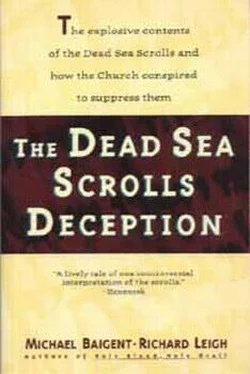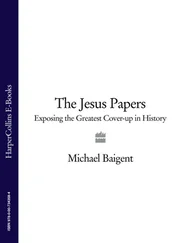Professor Philip Davies of Sheffield states that ‘most people who take time to study the issue agree that the use of paleography in Qumran research is unscientific’, adding that ‘attempts have been made to offer a precision of dating that is ludicrous’. 37Eisenman is rather more scathing, describing Birnbaum’s endeavours as ‘what in any other field would be the most pseudo-scientific and infantile methods’. 38To illustrate this, he provides the following example. 39
Suppose two scribes of different ages are copying the same text at the same time, and the younger scribe were trained more recently in a more up-to-date ‘scribal school’? Suppose the older scribe were deliberately using a stylised calligraphy which he’d learned in his youth? Suppose either or both scribes, in deference to tradition or the hallowed character of their activity, sought deliberately to replicate a style dating from some centuries before — as certain documents today, such as diplomas or certificates of award, may be produced in archaic copper-plate? What date could possibly be assigned definitively to their transcriptions?
In his palaeographic assumptions, Birnbaum overlooked one particularly important fact. If a document is produced merely to convey information, it will, in all probability, reflect the most up-to-date techniques. Such, for example, are the techniques employed by modern newspapers (except, until recently, in England). But everything suggests that the Dead Sea Scrolls weren’t produced merely to convey information. Everything suggests they had a ritual or semi-ritual function as well, and were lovingly produced so as to preserve an element of tradition. It is therefore highly probable that later scribes would deliberately attempt to reproduce the style of their predecessors. And, indeed, all through recorded history, scribes have consistently been conservative. Thus, for example, illuminated manuscripts of the Middle Ages contrived to reflect a sacred quality of antiquity, not the latest technological progress. Thus many modern Bibles are reproduced in ‘old-fashioned’ print. Thus one would not expect to find a modern Jewish Torah employing the style or technique used to imprint a slogan on a T-shirt.
Of the calligraphy in the Dead Sea Scrolls, Eisenman concludes that ‘they simply represent a multitude of different handwriting styles of people working more or less at the same time within the same framework, and tell us nothing about chronology at all’. 40Cecil Roth of Oxford was, if anything, even more emphatic: ‘In connection for example with the English records, although a vast mass of dated manuscript material exists covering the entire Middle Ages, it is impossible to fix precisely within the range of a generation the date of any document on the basis of palaeography alone.’ He warned that ‘a new dogmatism’ had arisen in the field of palaeography, and that ‘without any fixed point to serve as a basis, we are already expected to accept as an historical criterion a precise dating of these hitherto unknown Hebrew scripts’. He even, in his exasperation at the complacency and intransigence of the international team, had recourse to the unscholarly expedient of capital letters:
IT MUST BE STATED HERE ONCE AND FOR ALL THAT THE SO-CALLED PALAEOGRAPHICAL EVIDENCE IS WHOLLY INADMISSIBLE IN THIS DISCUSSION. 41
The reader by now will be familiar with the conclusions of the consensus view of the international team and, as expressed through its journals, the Ecole Biblique, as well as with the processes by which those conclusions were reached. It is now time to return to the evidence and see whether any alternative conclusions are possible. In order to do so, certain basic questions must again be posed. Who, precisely, were the elusive and mysterious denizens of Qumran, who established their community, transcribed and deposited their sacred texts, then apparently vanished from the stage of history? Were they indeed Essenes? And if so, what exactly does that term mean?
The traditional images of the Essenes come down to us from Pliny, Philo and Josephus, who described them as a sect or sub-sect of 1st-century Judaism. 1Pliny, as we have seen, depicted the Essenes as celibate hermits, residing, with ‘only palm-trees for company’, in an area that might be construed as Qumran. Josephus, who is echoed by Philo, elaborates on this portrait. According to Josephus, the Essenes are celibate — although, he adds, almost as an afterthought, ‘there is a second order of Essenes’ who do marry. 2The Essenes despise pleasure and wealth. They hold all possessions in common, and those who join their ranks must renounce private property. They elect their own leaders from amongst themselves. They are settled in every city of Palestine, as well as in isolated communities, but, even in urban surroundings, keep themselves apart.
Josephus portrays the Essenes as something akin to a monastic order or an ancient mystery school. Postulants to their ranks are subjected to a three-year period of probation, the equivalent of a novitiate. Not until he has successfully undergone this apprenticeship is the candidate officially accepted. Full-fledged Essenes pray before dawn, then work for five hours, after which they don a clean loincloth and bathe — a ritual of purification performed daily. Thus purified, they assemble in a special ‘common’ room and partake of a simple communal meal. Contrary to later popular misconceptions, Josephus does not describe the Essenes as vegetarian. They are said to eat meat.
The Essenes, Josephus says, are well versed in the books of the Old Testament and the teachings of the prophets. They are themselves trained in the arts of divination, and can foretell the future by studying sacred texts in conjunction with certain rites of purification. In their doctrine, according to Josephus, the soul is immortal but trapped in the prison of the mortal and corruptible body. At death, the soul is set free and soars upwards, rejoicing. Josephus compares Essene teaching to that of ‘the Greeks’. Elsewhere, he is more specific, likening it to the principles of the Pythagorean schools. 3
Josephus mentions Essene adherence to the Law of Moses: ‘What they reverence most after God is the Lawgiver, and blasphemy against him is a capital offence.’ 4On the whole, however, the Essenes are portrayed as pacifist, and on good terms with established authority. Indeed, they are said to enjoy the special favour of Herod, who ‘continued to honour all the Essenes’; 5‘Herod had these Essenes in such honour and thought higher of them than their mortal nature required… ‘ 6But at one point, Josephus contradicts himself — or perhaps slips his guard. The Essenes, he says:
despise danger and conquer pain by sheer will-power: death, if it comes with honour, they value more than life without end. Their spirit was tested to the utmost by the war with the Romans, who racked and twisted, burnt and broke them, subjecting them to every torture yet invented in order to make them blaspheme the Lawgiver or eat some forbidden food. 7
In this one reference, at variance with everything else Josephus says, his Essenes begin to sound suspiciously like the militant defenders of Masada, the Zealots or Sicarii.
With the exception of this one reference, Josephus’ account was to shape popular images of the Essenes for most of the ensuing two thousand years. And when the Aufklärung, the so-called ‘Enlightenment’, began to encourage ‘free-thinking’ examination of Christian tradition, commentators began to make connections between that tradition and Josephus’ Essenes. Thus, in 1770, no less a personage than Frederick the Great wrote definitively that ‘Jesus was really an Essene; he was imbued with Essene ethics’. 8Such apparently scandalous assertions proceeded to gain increasing currency during the latter half of the next century, and in 1863 Renan published his famous Vie de Jesus, in which he suggested that Christianity was ‘an Essenism which has largely succeeded’. 9
Читать дальше












